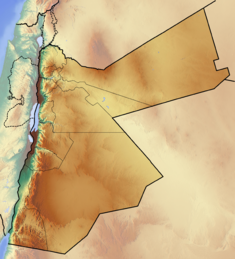Jawa Dam (Jordan)
| Jawa Dam | |
|---|---|
|
Location of Jawa Dam in Jordan
|
|
| Location | Jawa, Mafraq Governorate, Jordan |
| Coordinates | 32°20′06″N 37°00′12″E / 32.33500°N 37.00333°ECoordinates: 32°20′06″N 37°00′12″E / 32.33500°N 37.00333°E |
| Construction began | ~3000 BC |
| Dam and spillways | |
| Type of dam | Gravity, masonry |
| Impounds | Wadi Rajil |
| Height | 4.5 m (15 ft) |
| Length | 80 m (260 ft) |
| Width (base) | 4.5–5 m (15–16 ft) |
| Reservoir | |
| Creates | Jawa Reservoir |
| Total capacity | 31,000 m3 (1,100,000 cu ft) est. |
The Jawa Dam is the remains of an ancient masonry gravity dam on Wadi Rajil at Jawa in Mafraq Governorate, Jordan, 58 kilometres (36 mi) north of Azraq. It is the oldest known dam in the world, dating back to the fourth millennium BC. The dam was part of a water supply system that included other smaller dams, channels and deflectors across the wadi to support the short lived local town of Jawa. Therefore, the term Jawa Dams is sometimes used to describe the dams around Jawa. The Jawa Dam, though, is the largest of the dams and withheld the largest reservoir.
It is located on the southern edge of an area of basalt which runs across Syria and eastern Jordan and is an attempt to harness the major water resources of Wadi Rajil: a dry river bed which floods irregularly during the winter months. Wadi Rajil has a catchment area of 300 km2 reaching 35 km north into Jebel Druze. The basalt allows very little water to soak into the ground. Any rainfall in the mountains results in violent short lived flash floods. The total annual flow down the wadi at Jawa is estimated to be 2,000,000 m3 per year arriving in a few dramatic winter floods with flows of 80–110 m3/s. Research suggests that the community at Jawa could survive on 3% of that total flow: if they could store it in sufficient quantities to last through the four dry summer months. It would have to support their population of 2,000 to 5,000 as well as their large herds of sheep, goats and some cattle. Estimates based on bone counts indicate there may have been as many as 10,000 sheep and goats as well as 800 cattle. There were also 200 equids and 160 dogs. From seed remains it is apparent that some of the water was also used for irrigation agriculture. The inhabitants ate barley, wheat, chickpeas, lentils and grapes.
There are the remains of three dams across Wadi Rajul at Jawa. Two are deflection dams meant to channel water into a number of reservoirs. The third was an attempt at a reservoir dam, completely blocking the flow of the flood. It appears not to have survived more than one season. The other two probably ceased to function within a generation.
...
Wikipedia

